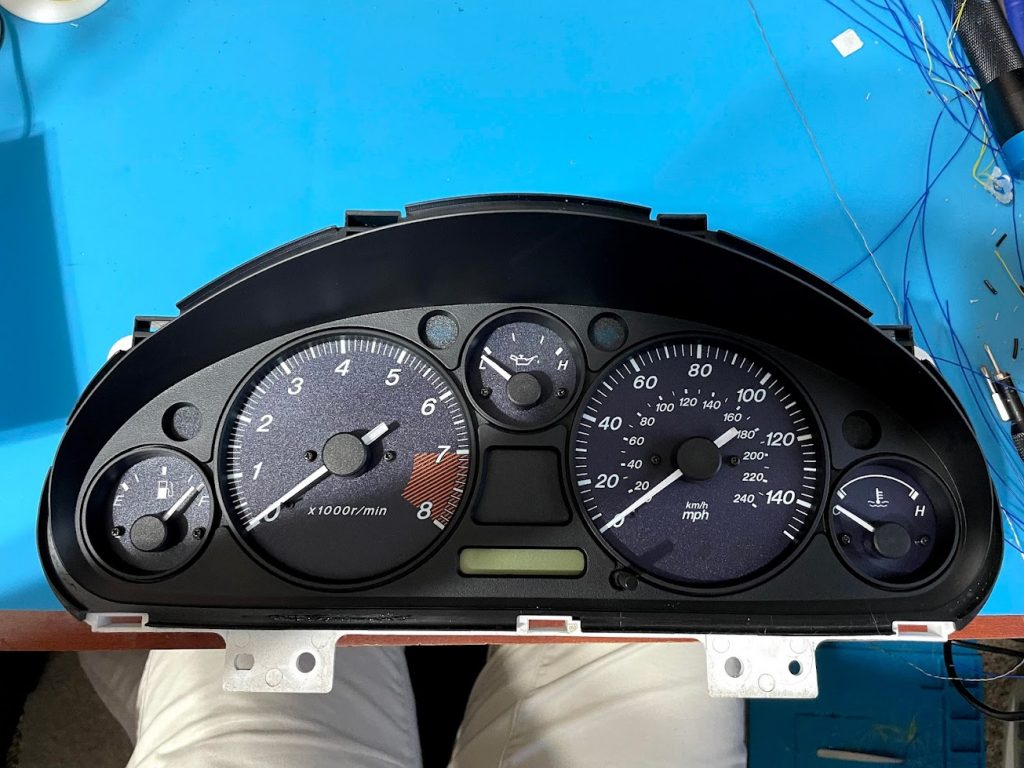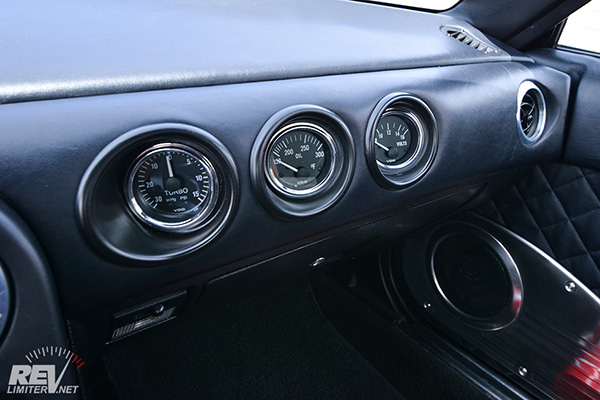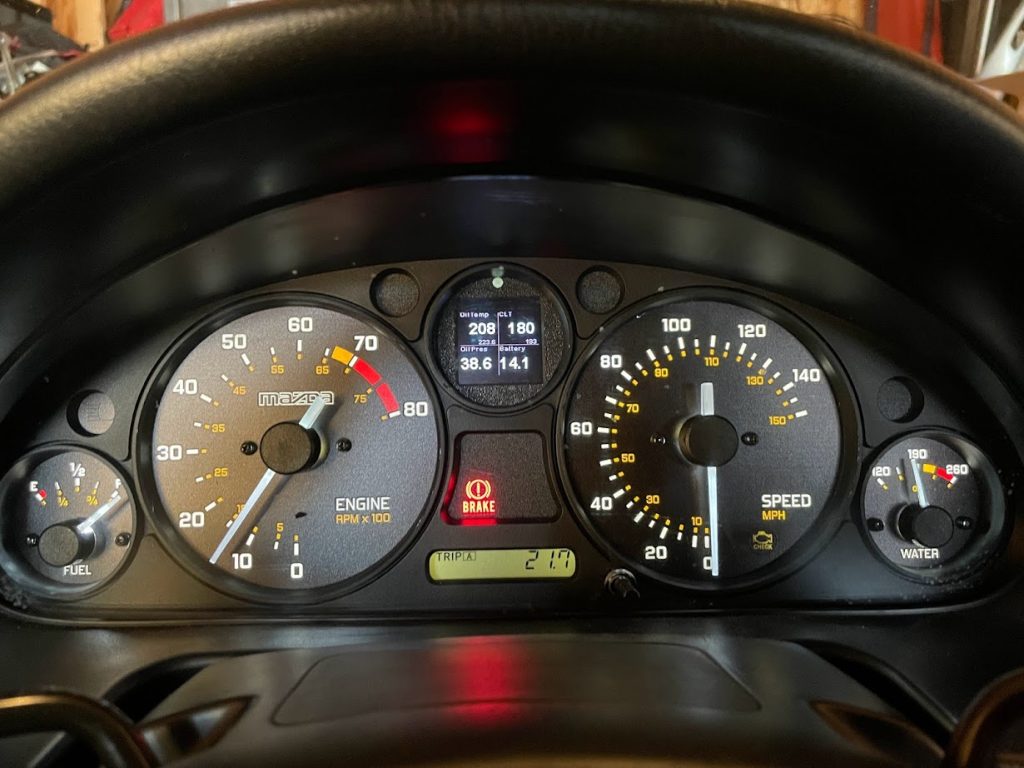NB Miata project – Gauge overhaul: RevLimiter gauge faces, CANchecked multifunction LCD

In a previous post I wrote about some of the cosmetic modifications I have done to my NB Miata. One of those modifications was the installation of a triple gauge pod A pillar so I could keep an eye on sensors while driving. It worked well, but there were some aspects that pushed me away from that gauge location. In this post I cover the CANchecked multifunction LCD gauge I replaced my gauge pod with, along with new RevLimiter gauge faces.
Stock NB Miata gauge cluster
NB Miatas have a pretty simple stock gauge cluster setup. On the left is a small fuel gauge, on the right is a small coolant temperature gauge, and in the upper middle is a small oil pressure gauge. To the left of the oil pressure gauge is a large tachometer, and to the right is a large speedometer. The problem with these gauges is that the oil pressure gauge and the coolant temperature gauge aren’t actually all that useful.
In the stock configuration the oil pressure gauge acts as more of a very damped “on” or “off” gauge. Meaning that once the engine is running and has oil pressure the gauge doesn’t move at all, and then when you shut off the engine (or completely lose oil pressure) the gauge will slowly return to zero. In other words it’s basically useless since you can’t tell if the pressure is too high, and by the time it reads too low it’s already most likely too late.
The stock coolant gauge is slightly more useful. It will read low when you startup the car, then it will slowly rise to operating temperature just like the car, and then eventually reach operating temperature. That seems fine, but the problem is that the gauge reads at the operating temperature for a very wide temperature range. It only starts to climb up once you get the coolant really hot. So in reality this gauge is more of a “warming up”, or “around operating temperature”, or “overheating” gauge.
Early NA6 Miatas had an actual functioning oil pressure gauge, and it is possible to fix the stock gauges on the NB Miata to varying degrees, but I didn’t really think it was worth the effort.
My triple gauge pod pillar setup
In order to get real sensor readings from my engine I needed to install new sensors to pair with new gauges. A very common way to do this is to add gauges to the driver side A pillar, which is the setup I went with.
I chose some Innovative Motorsports dual function gauges to maximize the information being displayed. Displayed information included vacuum/boost, oil temperature, oil pressure, coolant temperature, and battery voltage. In addition I had installed an AEM air fuel ratio gauge in the driver side climate control vent (they happen to be the correct size for a gauge).
These gauges worked perfectly fine, but I found that they created an annoying forward visibility blind spot that was super annoying, especially in tight autocross courses. Plus the fitment wasn’t the best (it wasn’t the right size to replace the stock pillar so I had to combine the two pillars), and there were just a ton of wires going through the car and into the pillar making a mess. So I was on the lookout for other solutions.
Miata gauge installation locations
I spent a lot of time looking at where other Miata owners installed their gauges. One of the drawbacks of a Miata when it comes to installing gauges is the very limited interior room and small dashboard. There just aren’t too many places to install gauges. Here’s what I found:
- A pillar gauges – These work, but you can only really get one gauge at the bottom before you start impacting visibility.
- Climate control vents – The vents on the sides of the car can be hard to see when driving, but the ones in the center are a pretty good spot. On a dedicated track car this makes sense, but not as much on a car you plan to drive on the street.
- Radio DIN gauges – There are plates that can install triple gauges in a single radio din. I was really considering this option since it seems perfect. Use a single DIN for three gauges, and the second DIN for a radio. The problem with this is that I couldn’t really find any single DIN radios that I liked the look of, and didn’t want to go back to a factory radio that lacks Bluetooth.
- Dashboard gauges – One of the options that I really liked the look of was gauges that are installed into the passenger side of the dashboard. The problem is that this only really works on the early NA dashboards that lack passenger airbags.
- Gauge cluster gauge replacements – There are some smaller gauges that can fit into the gauge cluster and replace the existing gauges. The problem with these is they tend to require a decent amount of work and fabrication.
- Miscellaneous other locations – I’ve seen some that mount to the gauge hood, or to the windshield, and many other less common mounting locations.
CANchecked multifunction LCD gauge cluster gauge, the solution?
Eventually I ended up running across a video showing the CANchecked MFA 2.0 multifunction display for the Miata. It is a small LCD display that screws right into the factory oil pressure gauge mounting location in the gauge cluster. To me this seemed like the perfect gauge for me. I could have a single gauge that can display any number of sensors (up to 6 on the screen at the same time) across multiple dashboards for different use cases.
It was pricey, but there really isn’t anything else that fits so nicely into the Miata, so I ordered one.
There are two ways this gauge gets data. One is through the CAN bus protocol your ECU outputs. NA/NB Miatas don’t have a CAN bus compatible ECU from the factory, so you’ll need to install a standalone ECU like a Megasquirt and configure it to output sensor data over CAN bus. I haven’t tried using the gauge without it being connected to Megasquirt, but it may be possible to use something like an Arduino to translate the stock ECU data to CAN bus.
The second way the gauge gets data is through four analog inputs. These are what I used to wire up my oil pressure, oil temperature, and (eventually) coolant temperature sensors. Keep in mind that there is limited compatibility for nonlinear sensors. It may also be possible to connect additional analog sensors directly through to analog inputs on your ECU, or through anything that can output sensor data over CAN bus.
Overall I’ve been very pleased with this gauge. My biggest complaint is that it isn’t quite bright enough to be readable in direct sunlight.
RevLimiter aftermarket gauge cluster faces
There isn’t really anything wrong with the stock Miata gauge cluster gauge face designs, but I’ve seen a few cars with aftermarket RevLimiter faces that looked really good. I figured I’d order a set of RevLimiter faces myself to upgrade the look of my car.
They sell many different gauge face designs and even allow custom orders (either modifications to existing designs, or new designs from scratch if you are willing to pay for it). I chose the JNC design because I liked the clean simple design, and the numbering. The website says there was inspiration from multiple classic Japanese cars in the design. Along with the gauge faces I got a set of replacement white LED lights to replace the old green bulbs in my gauge cluster.
The quality of the gauge faces meets (or maybe even exceeds) OEM quality. Installation wasn’t difficult, but be sure to pay close attention to the instructions since there are a lot of small ways to make mistakes. I have no complaints with the gauge faces at all, well worth the money.
Final thoughts
The CANchecked multi function gauge in combination with RevLimiter gauge faces really improve the looks and functionality of the stock Miata gauge cluster. I’d definitely recommend both products for those looking to change up the look of their gauges, or add additional information to the cluster.
In the future I’d really like to add additional sensors to my Miata to data log while on track and maybe get some better insight on what’s working and what isn’t, so that I can become a better driver. I’m also just a really big fan of data. I’ll most likely be installing a RaceCapture Pro logger some time in the near future. It can log ECU data over CAN bus, aftermarket sensors, as well as built in accelerometer and high frequency GPS data. I’m not sure what all I’m going to log, but things like brake pressure, throttle position, wheel speed, and ride height come to mind.





